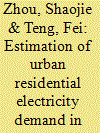|
|
|
Sort Order |
|
|
|
Items / Page
|
|
|
|
|
|
|
| Srl | Item |
| 1 |
ID:
092814


|
|
|
|
|
| Publication |
2009.
|
| Summary/Abstract |
This study estimates the electricity demand function for the residential sector of South Korea with the aim of examining the effects of improved energy efficiency, structural factors and household lifestyles on electricity consumption. In the study, time series data for the period from 1973 to 2007 is used in a structural time series model to estimate the long-term price and income elasticities and annual growth of underlying energy demand trend (UEDT) at the end of the estimation period. The result shows a long-term income elasticity of 1.33 and a long-term price elasticity of ?0.27% with ?0.93% as the percentage growth of UEDT at the end of the estimation period. This result suggests that, in order to encourage energy efficiency in the residential sector, the government should complement the market based pricing policies with non-market policies such as minimum energy efficiency standards and public enlightenment.
|
|
|
|
|
|
|
|
|
|
|
|
|
|
|
|
| 2 |
ID:
125526


|
|
|
|
|
| Publication |
2013.
|
| Summary/Abstract |
This paper uses annual urban household survey data of Sichuan Province from 2007 to 2009 to estimate the income and price elasticities of residential electricity demand, along with the effects of lifestyle-related variables. The empirical results show that in the urban area of Sichuan province, the residential electricity demand is price- and income-inelastic, with price and income elasticities ranging from -0.35 to -0.50 and from 0.14 to 0.33, respectively. Such lifestyle-related variables as demographic variables, dwelling size and holdings of home appliances, are also important determinants of residential electricity demand, especially the latter. These results are robust to a variety of sensitivity tests. The research findings imply that urban residential electricity demand continues to increase with the growth of income. The empirical results have important policy implications for the Multistep Electricity Price, which been adopted in some cities and is expected to be promoted nationwide through the installation of energy-efficient home appliances.
|
|
|
|
|
|
|
|
|
|
|
|
|
|
|
|
| 3 |
ID:
175237


|
|
|
|
|
| Summary/Abstract |
This study investigates the drivers of residential electricity demand in Saudi Arabia at a regional level for the period 1990–2018 using Structural Time Series Modeling. We find that Saudi Arabia's two waves of energy price reforms in 2016 and 2018 have had different impacts on residential electricity consumption across its regions. The empirical estimation results show that the long-run price responses of residential electricity demand vary across regions: from −0.20 in the Central region to −0.46 in the Eastern region. The short-run elasticities are −0.10 for the Central and Western regions, −0.15 in the Southern region, while the Eastern region's demand does not respond to price changes in the short run. The long run income elasticities of the regions' residential electricity demand also differ considerably: from 1.02 in the Western region to 0.27 in the Eastern region. The short-run income elasticities are 0.14 and 0.43 for the Eastern and Western regions, respectively while the residential electricity demand in the Central and Southern regions' does not react to income changes. We further estimate that hot weather conditions significantly impact all regions' residential electricity demand. Finally, we find that all regions saw some efficiency improvements in light of the energy price reforms, although there is a room for further improvements. The findings of the study can be useful for policymakers through the ways that we discussed in the paper.
|
|
|
|
|
|
|
|
|
|
|
|
|
|
|
|
| 4 |
ID:
150022


|
|
|
|
|
| Summary/Abstract |
Price elasticity estimates of residential electricity demand vary widely across the energy economics and policy literature. In this paper, we seek to explain these findings using three nationwide datasets from the U.S. – the American Housing Survey, Forms EIA-861, and the Residential Energy Consumption Survey. We examine the role of the sample period, level of aggregation, use of panel data, use of instrumental variables, and inclusion of housing characteristics and capital stock. Our findings suggest that price elasticities have remained relatively constant over time. Upon splitting our panel datasets into annual cross sections, we do observe a negative relationship between price elasticities and the average price. Whether prices are rising or falling appears to have little effect on our estimates. We also find that aggregating our data can result in both higher and lower price elasticity estimates, depending on the dataset used, and that controlling for unit-level fixed effects with panel data generally results in more inelastic demand functions. Addressing the endogeneity of price and/or measurement error in price with instrumental variables has a small but noticeable effect on the price elasticities. Finally, controlling for housing characteristics and capital stock produces a lower price elasticity.
|
|
|
|
|
|
|
|
|
|
|
|
|
|
|
|
|
|
|
|
|